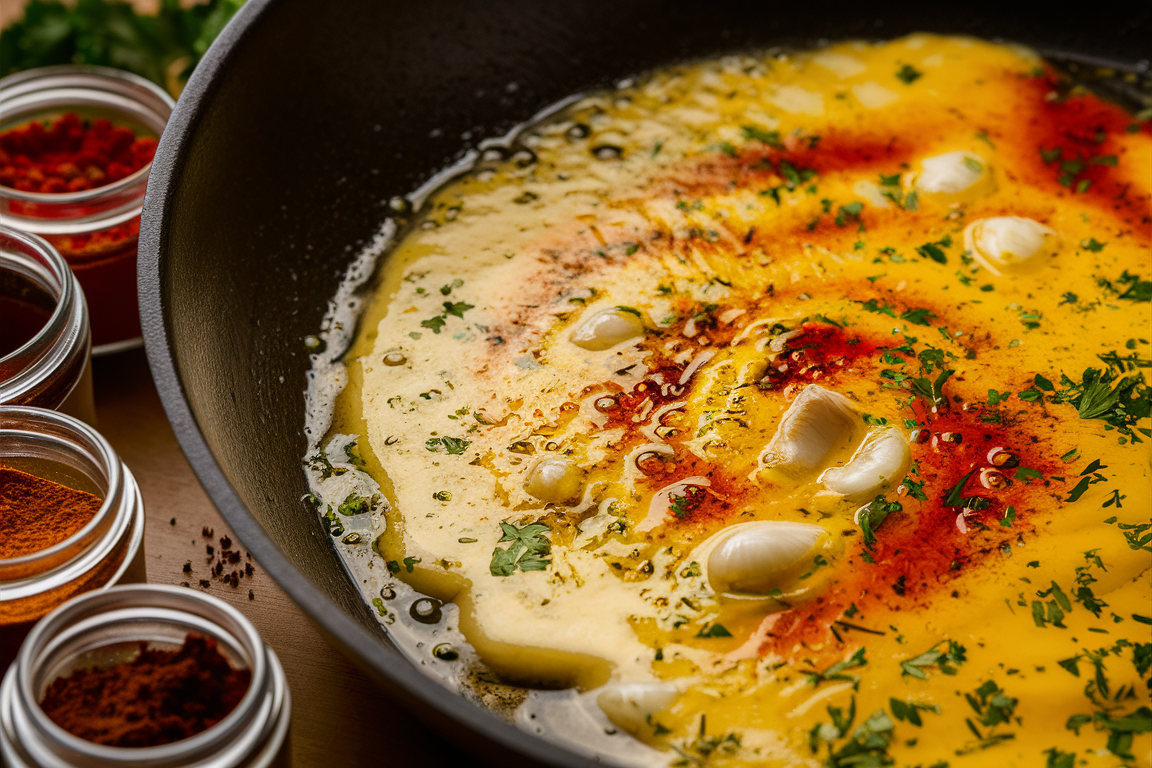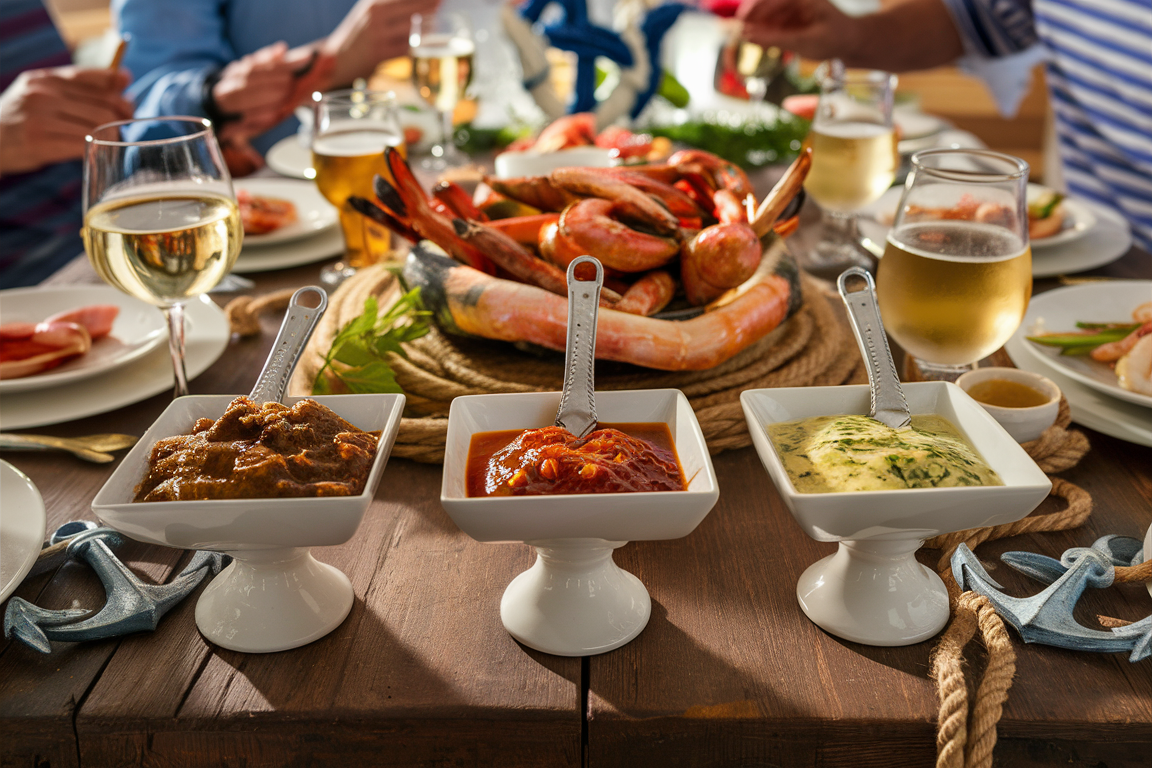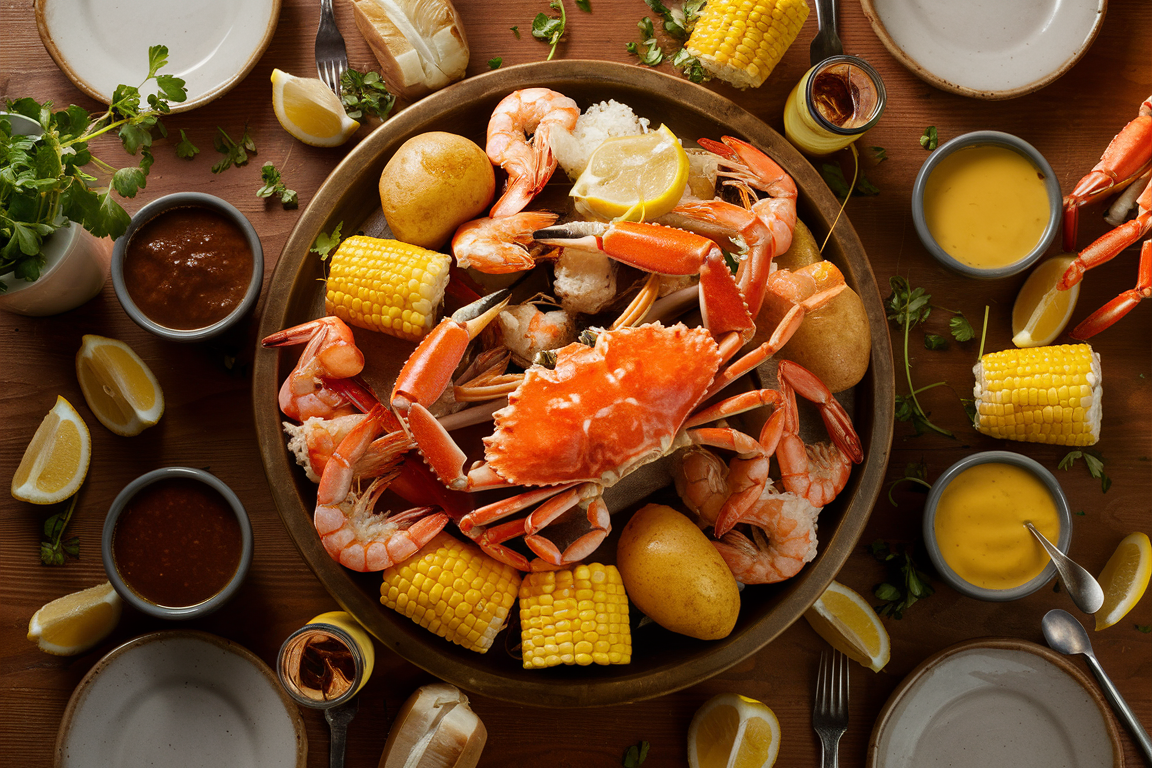Seafood boil sauce is the soul of a seafood boil, adding flavor and richness to a gathering that’s as much about the experience as it is about the food. In this guide, we’ll explore everything you need to know about seafood boil sauce, from its origins and ingredients to the best recipes and variations.
What is a Seafood Boil Sauce?
A seafood boil sauce is a flavorful condiment used to enhance the taste of boiled seafood like crab, shrimp, and crawfish. Traditionally served alongside seafood boils, this sauce can be drizzled, dipped, or poured over a mix of shellfish, corn, and potatoes. Its richness and spice are what make it a cornerstone of seafood boils across the country.

Origins of Seafood Boil Sauce
Regional Variations Across the United States
The history of seafood boil sauce is deeply rooted in Southern cuisine. Louisiana, the epicenter of the Cajun and Creole culinary tradition, has heavily influenced the modern-day recipes. Cajun boil sauces are famous for their bold flavors, combining paprika, cayenne, garlic, and butter.
Other regions, like the East Coast, favor milder and herbaceous sauces, incorporating ingredients like Old Bay seasoning and fresh lemon juice. In contrast, the West Coast often embraces fusion-style sauces, adding Asian-inspired elements.
Popular Culinary Traditions
The communal aspect of seafood boils reflects the vibrant culture of the South. Gathering around a large pot of boiling seafood, paired with spicy and savory sauces, is a tradition that brings families and friends together.
Essential Ingredients for a Flavorful Seafood Boil Sauce
The perfect seafood boil sauce relies on layers of flavor. Below are the essential ingredients that make the sauce unforgettable:
Spices and Herbs
At the heart of any seafood boil sauce are bold spices. A mix of paprika, cayenne, chili powder, and garlic powder creates depth, while herbs like parsley and thyme add freshness.
Butter: The Key to Richness
Butter is the base of most seafood boil sauces. Its creamy texture and ability to absorb spices provide the richness that coats the seafood evenly. For added flair, some recipes incorporate browned butter for a nutty undertone.
Garlic and Onion for Depth
Garlic is a star player, often used in generous quantities. Its roasted and caramelized flavor brings out the sweetness of seafood, while onion—whether sautéed or powdered—adds a savory dimension.
The Role of Heat: Paprika, Cayenne, and Chili Powder
Heat levels can vary, but a classic seafood boil sauce includes a fiery kick. Paprika and cayenne pepper are common, while chili powder adds smoky undertones. Adjust the heat to your preference by playing with these spices.
Choosing the Right Seasonings
When it comes to seasonings, the right balance is key to enhancing the flavor of the seafood without overpowering it.
Seasoning Mixes for Seafood
Popular blends like Old Bay, Cajun seasoning, or Creole seasoning are perfect for seafood boil sauces. These pre-made mixes often combine paprika, celery salt, black pepper, and mustard seed, making them convenient and versatile.
Homemade vs. Store-Bought Options
While store-bought mixes are convenient, making your own seasoning blend gives you control over salt levels and flavor profiles. A homemade mix allows you to customize spice levels and avoid any unnecessary additives.
Popular Types of Seafood Boil Sauces
Depending on your palate, there are several delicious variations of seafood boil sauces to explore:
Garlic Butter Sauce
This classic option combines melted butter, minced garlic, and a splash of lemon juice. It’s perfect for those who love a rich, creamy, and slightly tangy flavor.
Spicy Cajun Sauce
For those who prefer bold and spicy flavors, Cajun sauce is the way to go. Loaded with cayenne, paprika, and Cajun seasoning, this sauce delivers a fiery punch.
Lemon Herb Sauce
Light and refreshing, a lemon herb sauce incorporates fresh lemon juice, parsley, and dill. This is ideal for lighter seafood like shrimp or scallops.
How to Adjust Spice Levels
Tips for Mild Flavors
- Reduce the amount of cayenne and chili powder.
- Add more butter or cream to balance the heat.
- Incorporate sweet elements like honey or sugar.
Making It Extra Spicy
- Double the cayenne pepper or add red pepper flakes.
- Use hot sauce or Sriracha for an additional kick.
- Add jalapeños or serrano peppers for fresh heat.
Step-by-Step Seafood Boil Sauce Recipe
Creating the perfect seafood boil sauce at home is easier than you think. Follow this step-by-step guide to craft a flavorful sauce that complements your seafood boil feast.
Preparing Your Ingredients
The foundation of a good seafood boil sauce lies in properly prepared ingredients. This step ensures every flavor is maximized.

Chopping and Prepping Garlic, Onion, and Herbs
- Garlic: Mince fresh garlic finely for a stronger flavor. Use pre-minced garlic for convenience, but fresh garlic provides the best results.
- Onion: Dice onions finely to ensure they melt into the sauce during cooking.
- Herbs: Chop fresh parsley, thyme, or dill to add a burst of freshness at the end.
Measuring the Right Amount of Spices
Accurate measurements of spices are crucial for achieving a balanced flavor profile. Use a teaspoon or tablespoon to measure key spices like paprika, cayenne, garlic powder, and onion powder. Adjust to taste as you go.
Melting and Infusing Butter
Butter is the base for most seafood boil sauces, so handling it correctly is essential.
Techniques for Preventing Burnt Butter
- Use medium-low heat when melting butter to prevent it from burning.
- If using unsalted butter, add a pinch of salt to enhance its flavor.
- Stir constantly while melting to ensure even heat distribution.
Infusing Aromatics Properly
Once the butter is melted, add your minced garlic and onions. Cook them on low heat until they are golden and fragrant. This step ensures the butter absorbs the aromatic flavors, creating a rich base for your sauce.
Combining Spices for the Sauce
A well-balanced mix of spices is what elevates the sauce from good to amazing.
Creating a Balanced Flavor Profile
- Start with 2 teaspoons of paprika, 1 teaspoon of cayenne, and 1 teaspoon of garlic powder.
- Add 1/2 teaspoon of black pepper and 1/4 teaspoon of chili powder for depth.
- Incorporate a pinch of sugar to balance the heat with a subtle sweetness.
Avoiding Overpowering Ingredients
- Add spices gradually and taste as you go.
- Use no more than one overpowering spice (like cayenne or chili powder) in large quantities.
- Balance strong flavors with butter, cream, or lemon juice.
Cooking the Sauce to Perfection
Cooking is where all the flavors meld together to create the final product.
Simmering Tips for Richness
- Allow the sauce to simmer on low heat for about 10-15 minutes. This slow cooking process enhances the flavors.
- Stir occasionally to prevent spices from settling at the bottom.
How Long to Cook for Best Results
- Short cooking times (under 10 minutes) will yield a fresher, lighter flavor.
- Longer cooking times (15 minutes or more) develop a deep, rich flavor ideal for bold seafood dishes.
Finishing Touches for the Sauce
Adding the final elements ensures your seafood boil sauce stands out.
Adding Lemon Juice for Zest
A splash of fresh lemon juice at the end brightens the sauce, balancing its richness with zesty acidity. Avoid adding lemon juice earlier, as prolonged cooking can dull its flavor.
Optional Garnishes: Parsley, Green Onions, etc.
- Sprinkle chopped parsley for color and freshness.
- Add sliced green onions for a mild oniony bite.
- For extra flair, consider a pinch of red pepper flakes or a dollop of hot sauce.
Serving the Seafood Boil Sauce
The sauce can be served in multiple ways depending on your preference and the type of seafood boil.
Pairing with Shellfish
- Use garlic butter sauce for crab legs and lobster tails.
- Try spicy Cajun sauce with shrimp and crawfish.
- Opt for lemon herb sauce for lighter options like scallops.
Best Ways to Serve
- Drizzle the sauce over cooked seafood.
- Serve it on the side as a dipping sauce.
- Toss the boiled seafood directly in the sauce for even coating.
Storing and Reheating the Sauce
Seafood boil sauce can be made in advance or stored for later use.
Freezing for Future Use
- Pour the sauce into an airtight container or freezer-safe bag.
- Freeze for up to 3 months.
- Thaw in the refrigerator before reheating.
Reheating Without Losing Flavor
- Warm the sauce on low heat to prevent separating.
- Add a splash of water or broth if the sauce thickens too much during storage.
- Stir thoroughly to ensure an even texture.
Creative Variations of Seafood Boil Sauce
While traditional seafood boil sauces like garlic butter or spicy Cajun remain popular, there’s plenty of room to explore creative variations inspired by global flavors and dietary preferences. In this section, we dive into unique ideas to elevate your seafood boil experience.

Asian-Inspired Seafood Boil Sauces
Asian flavors bring a delightful twist to traditional seafood boil sauces. They offer a balance of sweet, savory, and umami flavors.
Soy-Ginger Variations
This variation combines the richness of soy sauce with the freshness of ginger.
- Key Ingredients: Soy sauce, fresh ginger, garlic, sesame oil, and a hint of brown sugar.
- How to Prepare: Sauté garlic and ginger in sesame oil. Add soy sauce, brown sugar, and a splash of rice vinegar for balance.
- Pairing Tip: Perfect with shrimp or crab for a flavorful umami boost.
Spicy Korean Gochujang Sauce
For a bold, spicy kick, Gochujang (Korean chili paste) offers the perfect base.
- Key Ingredients: Gochujang, soy sauce, honey, garlic, and sesame oil.
- How to Prepare: Mix Gochujang with soy sauce and honey. Simmer with minced garlic and a touch of sesame oil.
- Pairing Tip: This sauce pairs beautifully with crawfish or lobster.
Mediterranean-Inspired Sauces
Mediterranean sauces focus on fresh, herbaceous, and olive oil-rich flavors, perfect for lighter seafood dishes.
Olive Oil and Herb-Based Variations
- Key Ingredients: Extra virgin olive oil, lemon juice, oregano, thyme, and minced garlic.
- How to Prepare: Warm olive oil with garlic. Stir in fresh herbs and a squeeze of lemon juice.
- Pairing Tip: Best suited for scallops or white fish, as the sauce highlights delicate flavors.
Vegan and Dairy-Free Options
For those avoiding dairy or seeking plant-based alternatives, these sauces deliver bold flavors without butter.
Substituting Butter with Plant-Based Alternatives
- Use vegan butter made from coconut oil or cashew cream for a rich texture.
- Substitute with olive oil or avocado oil for a lighter feel.
How to Achieve Creaminess
- Incorporate coconut milk for a velvety consistency.
- Blend soaked cashews with water to create a creamy, dairy-free base.
Kid-Friendly Seafood Boil Sauces
Not everyone enjoys the bold spices of a seafood boil sauce. For younger palates, consider mild, flavorful options.
Reducing Spice Levels for Younger Palates
- Eliminate cayenne and chili powder.
- Focus on buttery, garlicky flavors with a touch of honey or sugar for sweetness.
Fun Presentation
- Serve the sauce in small dipping bowls with colorful garnishes like parsley.
- Let kids customize their sauces with mild add-ons like lemon juice or grated cheese.
Pairing Sauces with Beverages
The right beverage can elevate the seafood boil experience, balancing the sauce’s richness or heat.
Beer and Wine Recommendations
- For Garlic Butter Sauce: Pair with a crisp white wine like Sauvignon Blanc or a light lager.
- For Spicy Cajun Sauce: Opt for a hoppy IPA to match the heat or a Riesling to cool the palate.
- For Lemon Herb Sauce: Sparkling water with a splash of lemon or a dry rosé complements the zesty flavors.
Hosting a Seafood Boil Party
Make your seafood boil party unforgettable by integrating creative presentation ideas and interactive elements.
Theme Ideas and Presentation Tips
- Serve the seafood boil on a long table covered with parchment paper for a rustic, communal vibe.
- Add thematic decor like nautical elements, crab mallets, and bibs for guests.
DIY Sauce Stations
- Set up a station with multiple sauce options like garlic butter, Cajun, and lemon herb.
- Provide small bowls and allow guests to customize their sauce with extra spices, herbs, or lemon wedges.
Troubleshooting Common Mistakes
Mistakes can happen, but with a few adjustments, you can save your sauce.
Fixing Overly Spicy Sauces
- Add more butter or cream to mellow the heat.
- Incorporate a teaspoon of sugar or honey to balance the spice.
- Serve with additional lemon juice to tone down the intensity.
Avoiding Greasy Textures
- Use a whisk to emulsify the sauce thoroughly.
- Add a splash of broth or water to thin out overly greasy sauces.
Nutrition and Health Aspects
Seafood boil sauces are rich and indulgent, but you can tweak recipes to suit dietary goals.
Calorie Breakdown
- Butter-Based Sauces: Higher in calories due to the butter.
- Olive Oil-Based Sauces: A lighter, heart-healthy option with fewer calories.
- Low-Fat Options: Replace some butter with vegetable broth or use plant-based alternatives.
Reducing Sodium Content
- Use low-sodium versions of soy sauce or seasoning blends.
- Skip pre-salted butter and adjust salt levels manually.
FAQs About Seafood Boil Sauces
- What’s the best sauce for crab?
- Garlic butter sauce pairs perfectly with crab, complementing its sweet meat.
- What’s ideal for shrimp boils?
- Spicy Cajun sauce adds bold flavors to shrimp boils.
- Can I make seafood boil sauce in advance?
- Yes, prepare it a day ahead and store it in the fridge for easy reheating.
- How long does seafood boil sauce last?
- Refrigerate for up to 5 days or freeze for up to 3 months.
- Can I use margarine instead of butter?
- Yes, but it may lack the rich flavor of butter.
- What’s a good dairy-free substitute?
- Olive oil or vegan butter are excellent options.
- How do I adjust spice levels for guests?
- Offer multiple sauce variations, from mild to spicy.
- Can I reuse leftover sauce?
- Yes, reheat and toss with fresh seafood or use as a dipping sauce.
- What’s the difference between Cajun and Creole sauces?
- Cajun is spicier, while Creole includes more herbs and tomatoes.
- What seafood pairs best with lemon herb sauce?
- Scallops, shrimp, and white fish benefit most from its fresh, zesty flavors.

